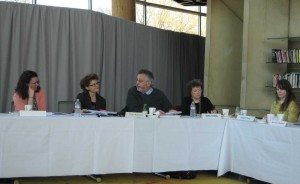The mission of the John A. Hartford Foundation is to improve the health of older Americans, which we feel is a critical element of an equitable and ethical society. As I’ve written many times and in many ways, older adults get lower quality health care than other age groups despite the fact that the quality of their care makes a greater difference to their well-being and independence than for almost any other age group.
 Nonetheless, while it may be true, as Virgil put it, that “the greatest wealth is health,” I think the point of good health is that it enables you to do and enjoy things you care about. Thus while the Foundation is a proud member of Grantmakers in Health, we are also very proud to be a founding member of Grantmakers in Aging, a big-tent affinity organization working to make aging better and make an aging world a better place.
Nonetheless, while it may be true, as Virgil put it, that “the greatest wealth is health,” I think the point of good health is that it enables you to do and enjoy things you care about. Thus while the Foundation is a proud member of Grantmakers in Health, we are also very proud to be a founding member of Grantmakers in Aging, a big-tent affinity organization working to make aging better and make an aging world a better place.
 As a board member of GIA, I and GIA executive director Carol Farquhar recently attended a meeting with a second GIA (Grantmakers in the Arts) that reminded me of this big tent of aging. In this meeting, members and leaders of both GIAs struggled to discover the similarities and differences in our perspectives and develop a common language that would enable us to explore our shared interest: the intersection of aging and the arts. As with any kind of cross-cultural exploration, it wasn’t easy: the words were slippery, the goal of our conversation was often unclear, and I can’t say that I know yet where we
As a board member of GIA, I and GIA executive director Carol Farquhar recently attended a meeting with a second GIA (Grantmakers in the Arts) that reminded me of this big tent of aging. In this meeting, members and leaders of both GIAs struggled to discover the similarities and differences in our perspectives and develop a common language that would enable us to explore our shared interest: the intersection of aging and the arts. As with any kind of cross-cultural exploration, it wasn’t easy: the words were slippery, the goal of our conversation was often unclear, and I can’t say that I know yet where we  came out. Fortunately, we were joined by colleagues from two “bilingual” foundations, The Fan Fox and Leslie R. Samuels Foundation and The Metlife Foundation, who within their own programmatic work incorporate both aging and arts. With their help and good will on all sides, it felt like a good day’s work to search widely for new allies, new ideas, and new perspectives.
came out. Fortunately, we were joined by colleagues from two “bilingual” foundations, The Fan Fox and Leslie R. Samuels Foundation and The Metlife Foundation, who within their own programmatic work incorporate both aging and arts. With their help and good will on all sides, it felt like a good day’s work to search widely for new allies, new ideas, and new perspectives.
In the course of the conversation, I heard at least four different notions of the possible shared interests of the two GIAs:
- The fine art view: art is part of creating meaning in life for all people, including older adults.
- The economics of art view: the audiences for many kinds of arts (e.g., opera, dance) are aging, with implications for the viability of artistic enterprises and the possibility of generational shifts.
- The older artist view: as artists age they face particular challenges because of the life and economics of the calling.
- The art therapy view: art can be used to help sick older adults, such as those with Alzheimer’s disease. See the Museum of Modern Art's program here and here.
- The community capacity view: to remain vibrant, arts organizations must embrace older adults as well as other fast-growing populations.
The two GIAs will be continuing the conversation at a third Regional Issues Forum at the Museum of Modern Art in New York, NY, May 3. MoMA will be a perfect venue for foundations interested in aging and/or the arts to find common ground in order to make the lives of older adults—and artists—richer and more fulfilling.
